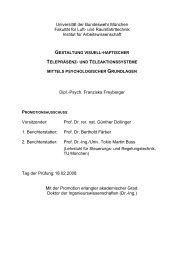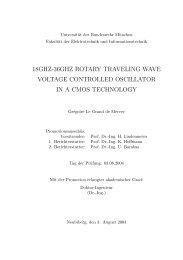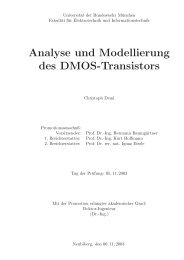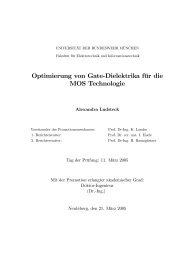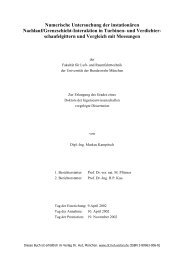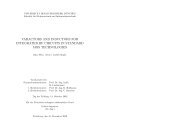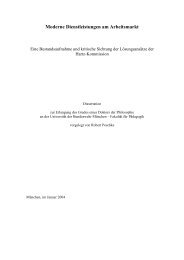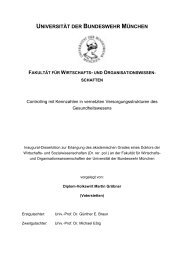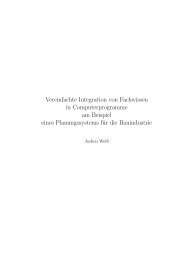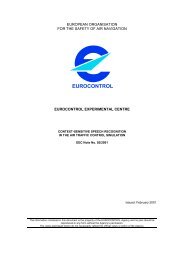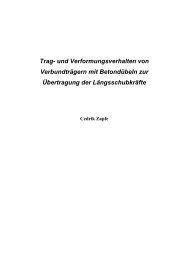Precise Orbit Determination of Global Navigation Satellite System of ...
Precise Orbit Determination of Global Navigation Satellite System of ...
Precise Orbit Determination of Global Navigation Satellite System of ...
You also want an ePaper? Increase the reach of your titles
YUMPU automatically turns print PDFs into web optimized ePapers that Google loves.
Chapter 4 Major Error Sources <strong>of</strong> <strong>Satellite</strong> Observations<br />
The effects <strong>of</strong> the atmosphere on radio signal propagation are mainly from two parts <strong>of</strong> the atmosphere, one is<br />
called troposphere and another is ionosphere.<br />
4.1.1 Tropospheric Error<br />
The troposphere is composed <strong>of</strong> dry gases and water vapor. Water vapor exists only below altitude <strong>of</strong> 12 km<br />
above sea level. Water vapor density varies widely with position and time and is much more difficult to predict<br />
than dry gases. Fortunately, however, water vapor effects represent only a relatively small fraction (≈1/10) <strong>of</strong><br />
total tropospheric error (Spiker, 1996). Dry gases are relatively uniform in its constituents. For L-band<br />
frequencies, oxygen, which is part <strong>of</strong> dry gases, is the dominant source <strong>of</strong> attenuation. Tropospheric errors cause<br />
the radio signal delay.<br />
The signal from the satellite is refracted by the troposphere as it travels to the users on or near the Earth’s<br />
surface. Tropospheric refraction causes a delay that depends upon the actual path <strong>of</strong> the ray and the refractive<br />
index <strong>of</strong> the gases along that path. For troposphere symmetric in azimuth about the user antenna, the delay<br />
depends only upon the vertical pr<strong>of</strong>ile <strong>of</strong> the troposphere and elevation angle to the satellite.<br />
There are several empirical models for computation <strong>of</strong> signal delay due to the tropospheric effects. Among them,<br />
Saastamoinen total delay model, Hopfield two quartic models and Black and Eisner model are more popularly<br />
used (H<strong>of</strong>mann-Wellenh<strong>of</strong> et al 1992, Leick 1995, Spiker, 1996).<br />
1)Saastamoinen model (Spiker, 1996)<br />
Tropospheric error which produces a signal delay and thus causes an increase in the observed range can be<br />
calculated by using Saastamoinen standard model as follows<br />
1255<br />
2<br />
∆Strop = 0. 002277( 1 + D)sec ψ 0[ P0<br />
+ ( + 0005 . ) e0− Btan ψ 0 ] + δ Rm<br />
(4-1)<br />
T<br />
0<br />
where ∆Strop is the delay correction in meters; P0 e0<br />
water vapor at sea level in millibars; T0 is the absolute temperature at sea level in °Kelvin; The correction term<br />
, are the atmospheric pressure and the partial pressure <strong>of</strong><br />
B and δ R are given in Table 4-2 (Spilker, 1996) for various tracking station heights h. The apparent zenith angle<br />
0<br />
ψ 0 = 90 − E in which E is the elevation <strong>of</strong> satellite related to the tracking station; the value D is<br />
D = 0. 0026cos 2ϕ + 0. 00028h,<br />
where ϕ is the local latitude, and h is the tracking station height in km.<br />
Table 4-2 Correction Terms for Saastamoinen Standard Model<br />
Apparent Zenith Tracking Station Height Above Sea Level<br />
Angle 0 km 0.5 km 1 km 1.5 km 2 km 3 km 4 km 5 km<br />
60°00’ 0.003 0.003 0.002 0.002 0.002 0.002 0.001 0.001<br />
66°00’ 0.006 0.006 0.005 0.005 0.004 0.003 0.003 0.002<br />
70°00’ 0.012 0.011 0.010 0.009 0.008 0.006 0.005 0.004<br />
73°00’ 0.020 0.018 0.017 0.015 0.013 0.011 0.009 0.007<br />
75°00’ 0.031 0.028 0.025 0.023 0.021 0.017 0.014 0.011<br />
δR m 76°00’ 0.039 0.035 0.032 0.029 0.026 0.021 0.017 0.014<br />
77°00’ 0.050 0.045 0.041 0.037 0.033 0.027 0.022 0.018<br />
78°00’ 0.065 0.059 0.054 0.049 0.044 0.036 0.030 0.024<br />
78°30’ 0.075 0.068 0.062 0.056 0.051 0.042 0.034 0.028<br />
79°00’ 0.087 0.079 0.072 0.065 0.059 0.049 0.040 0.033<br />
79°30’ 0.102 0.093 0.085 0.077 0.070 0.058 0.047 0.039<br />
79°45’ 0.111 0.101 0.092 0.083 0.076 0.063 0.052 0.043<br />
80°00’ 0.121 0.110 0.100 0.091 0.083 0.068 0.056 0.047<br />
B mb 1.156 1.079 1.006 0.938 0.874 0.757 0.654 0.563<br />
2) Hopfield Model (H<strong>of</strong>mann-Wellenh<strong>of</strong> et al 1992)<br />
Hopfield’s empirical representation <strong>of</strong> the dry refractivity as a function <strong>of</strong> the height h above the surface can be<br />
written as<br />
�hd−h�<br />
Nd( h) = Nd,<br />
0 � �<br />
� hd<br />
�<br />
4<br />
for h≤ hd= 43 km (4-2)<br />
32



